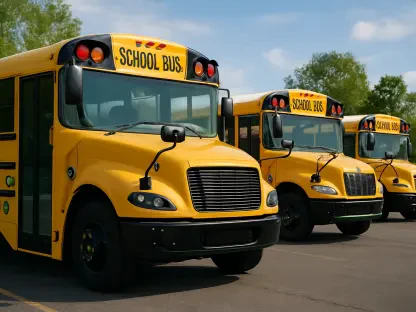In an era where digital platforms dominate student interactions and online threats loom larger than ever, schools are grappling with an entirely new frontier of safety challenges that extend far beyond the physical campus, demanding innovative strategies to protect students. From anonymous tips about potential violence to the sinister reach of extremist groups infiltrating gaming communities, the nature of danger has shifted dramatically into cyberspace. This article delves into the multifaceted strategies schools are employing to safeguard students, spotlighting the efforts of Arlington Public Schools (APS) in Virginia as a model for blending human expertise with digital awareness. As threats evolve with technology, educational institutions are compelled to adapt swiftly, balancing proactive measures with the need to maintain a nurturing environment. The urgency to protect young minds from both tangible and virtual harm has sparked innovative approaches, revealing a complex interplay of policy, training, and intervention that shapes the modern landscape of school safety.
Prioritizing Human Insight Over Technology
At the forefront of school safety strategies is a deliberate focus on human intervention rather than an over-reliance on cutting-edge technology. In Arlington Public Schools, professionals like Jared Hagenow, a dedicated threat assessment specialist, play a pivotal role in deciphering student behavior to prevent potential violence before it manifests. Instead of channeling significant funds into sophisticated tools such as AI-driven weapons detection systems, APS invests in a balanced approach that integrates physical security measures—like visitor screening protocols—with in-depth behavioral analysis. This method ensures that students are not subjected to an oppressive atmosphere of constant surveillance, preserving a sense of normalcy amid heightened safety concerns. Hagenow’s work often involves sifting through subtle cues and reports to identify risks, demonstrating that human judgment can be more nuanced and effective than automated solutions in addressing the root causes of threats within a school setting.
Further emphasizing this human-centric philosophy, Brandy Ellard, APS’s Assistant Director of School Safety and Emergency Management, advocates for creating an environment where students feel supported rather than confined. The aim is to avoid transforming schools into fortress-like spaces that might stifle learning and emotional growth. By fostering trust between students, staff, and safety personnel, APS seeks to encourage open communication, which is often critical in uncovering potential issues before they escalate. This approach stands in contrast to districts that prioritize high-tech security gadgets, reflecting a broader consensus among safety experts that understanding the psychological and emotional drivers behind student actions yields more sustainable safety outcomes. It’s a reminder that technology, while useful, cannot fully replace the empathy and insight brought by trained individuals who are attuned to the unique dynamics of a school community.
Behavioral Analysis as a Preventive Measure
Central to modern school safety protocols is the practice of behavioral threat assessment, a proactive strategy aimed at identifying and mitigating risks before they turn into crises. Specialists like Hagenow describe their role as akin to a predictive unit, working tirelessly to spot students who may be veering toward violence or self-harm. By employing vivid analogies—such as comparing a potential threat to a cat either stalking its prey or reacting defensively when cornered—Hagenow illustrates the diverse motivations behind harmful behaviors. This nuanced understanding allows for tailored interventions that address specific triggers, whether they stem from predatory intent or a reaction to perceived threats. Such assessments often rely on detailed observations from teachers, peers, and anonymous tips, ensuring a comprehensive view of a student’s state of mind and potential risk factors within the educational environment.
Beyond mere identification, behavioral threat assessment focuses on crafting individualized responses that prioritize support over punishment. Schools employing this method aim to redirect at-risk students through counseling, family engagement, and other resources rather than resorting to exclusionary measures like suspension. This approach not only mitigates immediate dangers but also contributes to long-term student well-being by addressing underlying issues such as bullying, mental health struggles, or social isolation. At APS, the integration of these assessments into daily safety practices underscores a commitment to prevention over reaction, ensuring that potential threats are defused discreetly and compassionately. The emphasis on human connection in these interventions highlights a critical shift in school safety paradigms, where understanding and empathy are as vital as any security protocol in maintaining a secure learning space for all students.
Navigating the Digital Threat Landscape
The rise of digital communication has introduced a complex layer of challenges for school safety, as online platforms often serve as both a breeding ground for threats and a source of early warning signs. Experts like Theresa Campbell, founder of Safer Schools Together, point out that students frequently leave digital “leakage”—public or semi-public indicators of harmful intentions—across social media and other online spaces. Historical tragedies, such as the Columbine shooting, have shown how such clues can be critical if detected in time, yet many educational institutions remain ill-equipped to monitor and interpret these digital footprints. The lack of specialized training for staff in this area often results in missed opportunities to intervene, leaving dangerous gaps in safety measures that could otherwise prevent devastating outcomes in schools across the nation.
Compounding this issue is the rapid evolution of digital spaces, where threats can emerge from unexpected corners with alarming speed. Schools are increasingly recognizing the need to adapt by integrating digital threat assessment into their safety frameworks, though implementation remains inconsistent due to resource constraints. Campbell’s frustration with recurring tragedies, where online warnings are overlooked, underscores the pressing need for comprehensive training programs that equip educators and safety personnel with the skills to navigate this virtual terrain. By prioritizing digital vigilance alongside traditional safety measures, schools can better anticipate and address risks that originate online, ensuring that they are not caught off guard by the subtle yet potent dangers lurking in students’ virtual interactions. This shift toward digital awareness marks a crucial step in modernizing school safety for an interconnected age.
Confronting Online Extremist Influences
An alarming and relatively new dimension of digital threats comes from online extremist networks that actively target vulnerable youth, exploiting their insecurities through popular platforms. Groups like the network known as 764 use gaming environments such as Minecraft and Roblox, as well as messaging apps like Discord and Telegram, to groom minors with violent and sexual content. FBI Director Kash Patel has labeled this phenomenon “modern-day terrorism,” highlighting the severe risks it poses to student safety. Both Hagenow and Campbell express deep concern over these predatory tactics, which often target impressionable individuals already grappling with emotional or social challenges. The urgency to counter such influences has made digital threat assessment an indispensable priority, pushing schools to rethink how they monitor and protect students in virtual spaces where traditional oversight falls short.
Addressing this insidious threat requires more than just awareness; it demands actionable training and resources for school staff to recognize and disrupt these dangerous interactions. The sophisticated grooming methods employed by extremist groups necessitate a proactive stance, where educators and safety specialists are equipped to identify warning signs in online behavior and intervene before harm occurs. Collaborative efforts with law enforcement and cybersecurity experts are also becoming essential, as schools alone cannot combat the scale of these networks. The chilling reality of such groups underscores the broader need for a cultural shift within educational systems, where digital literacy and safety training are embedded into the fabric of school policies. Only through such comprehensive measures can schools hope to shield students from the manipulative reach of online extremists seeking to exploit their vulnerabilities.
Addressing Policy Disparities in School Safety
Legislative and policy variations across regions present significant hurdles in standardizing school safety practices, particularly in the realm of threat assessment. Virginia has taken a leading role with mandatory behavioral threat assessment laws enacted in response to past tragedies, setting a benchmark for proactive safety measures. In contrast, areas like the District of Columbia operate under guidelines rather than legal requirements, resulting in uneven implementation. Jason Stoddard, President of the National Council of School Safety Directors, notes that a substantial number of school leaders nationwide lack formal mandates for threat assessment, revealing a fragmented system that undermines consistent protection for students. This disparity highlights the urgent need for unified national standards to ensure that all schools, regardless of location, are equipped to address modern threats effectively.
The push for policy reform is gaining traction among safety experts who advocate for increased resources and mandatory training to bridge these gaps. Without standardized requirements, many districts struggle to allocate funding or prioritize threat assessment, often leaving schools vulnerable to both physical and digital dangers. Stoddard’s observations from national conferences underscore the systemic nature of this challenge, where the absence of cohesive legislation hinders the adoption of best practices. To address this, there is a growing call for federal and state collaboration to establish clear guidelines and support mechanisms, ensuring that every educational institution has access to the tools and expertise needed for comprehensive safety protocols. Only through such concerted efforts can the patchwork of current policies be transformed into a robust framework that safeguards students uniformly across the country.
Striking a Balance Between Security and Freedom
One of the most delicate challenges schools face is maintaining a balance between robust security measures and preserving a supportive, open learning environment. At APS, Hagenow’s discreet investigations—often initiated by anonymous tips and conducted away from public view—exemplify an unseen layer of protection that contrasts with more overt measures like ID scanning at entry points. This dual approach ensures that safety efforts do not overshadow the primary mission of education, allowing students to engage in their daily activities without feeling overly monitored. The tension between implementing necessary precautions and avoiding an atmosphere of distrust remains a critical consideration, as schools strive to protect without alienating the very individuals they aim to serve in an increasingly complex threat landscape.
Equally important is the perspective of safety leaders like Brandy Ellard, who caution against turning schools into environments that feel restrictive or punitive. The goal is to integrate security seamlessly into the fabric of school life, ensuring that measures are both effective and unobtrusive. This balance requires ongoing dialogue with students, parents, and staff to gauge the impact of safety protocols on the school’s culture and make adjustments as needed. By prioritizing both physical and emotional well-being, schools can address modern threats—whether from digital extremists or behavioral risks—without sacrificing the sense of community that is essential for learning. This nuanced approach reflects a broader recognition that true safety encompasses not just protection from harm, but also the freedom to grow and thrive in a supportive setting.
Reflecting on Progress and Future Steps
Looking back, schools have made significant strides in adapting to the digital age’s unique threats, with institutions like APS demonstrating how human insight and behavioral analysis curbed potential violence through discreet, empathetic interventions. The emphasis on understanding digital “leakage” and countering extremist influences marked a pivotal shift in safety protocols, even as policy disparities revealed systemic shortcomings that need addressing. These efforts laid a foundation for a more proactive stance on student protection across varied threat landscapes.
Moving forward, the focus must shift to actionable solutions that close existing gaps, such as universal training for digital threat assessment and standardized national policies to ensure equitable safety measures. Collaboration between educators, policymakers, and law enforcement will be crucial in scaling successful models and equipping schools with necessary resources. By investing in both personnel and digital literacy, educational systems can build resilience against emerging dangers, ensuring that safety evolves alongside technology to protect future generations effectively.









